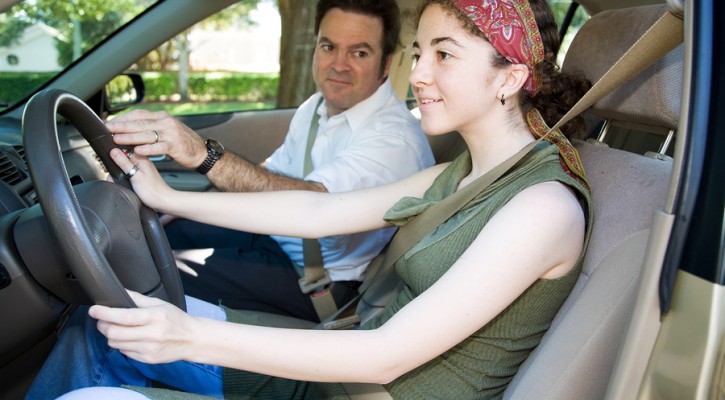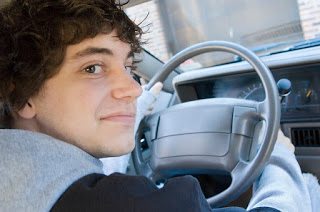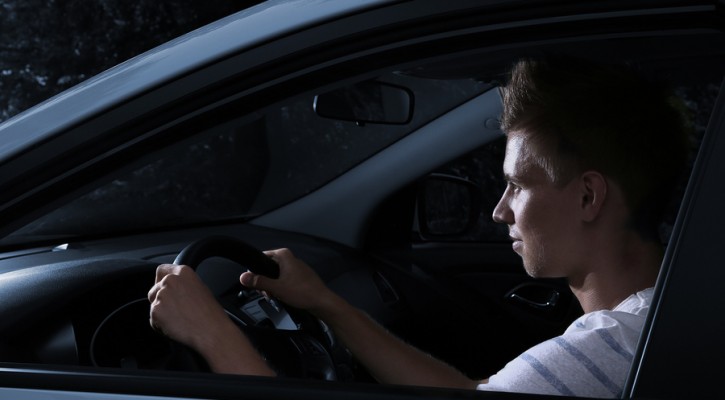Category Archive: Parents

Setting a Good Driving Example for Your Teen
February 20, 2009
Many parents hope that when they teach their teenagers how to drive, their children will do as they say, not as they do, when it comes to driving. But this hope may be unrealistic. Research indicates that children mimic their parents’ driving behaviors from as young as two years of age, so a parent’s bad driving habits may be deeply ingrained by the time training for a driver’s license begins. And teens are notoriously intolerant of what they view as hypocritical advice. When this is combined with over-confidence in their own abilities, your teen could develop bad driving habits early in the training process.
Before you begin teaching your teen to drive, it is a good idea to review and correct any poor driving habits you have developed over the years of driving. Remember that when your teen repeats these behaviors, s/he is doing so without the benefit of your years of driving experience and highly developed driving skills.
A good first step is to review your driving handbook. This will also assist you in knowing what important beginning driver training concepts to reinforce during lessons with your teen. As you review the handbook, make notes on the driving behaviors you need to change. For example, many drivers become lax about using the turn signal every time they change lanes, pull out from a parking space, enter or leave an expressway, or turn at intersections.
Lax driving behaviors are more likely to occur in familiar settings, so pay particular attention to your driving as you travel to and from work and school and on errands. Pretend that these routes are unfamiliar to you. How would you change your driving behavior? Take different routes to and from work, school and errands. Does your driving improve?
Third, begin training early by talking to your teen about your own driving behaviors. As you drive, point out potential hazards as you scan ahead. When you take action, explain what you are doing and why.
Teaching teens to drive should be a process, not an event. It’s important to realize that whether you intend to or not, you are teaching your child to drive every time you get behind the wheel with your child as a passenger.

How to Lower Your Teens Auto Insurance Rates
February 5, 2009
As with your own auto insurance rates, your teen’s rates are comprised of several factors believed to determine the risk the insurance company takes when selling you a policy that covers your child. Unfortunately, teens fall into a high-risk category at once due to age – mile for mile, teenagers are involved in three times as many fatal crashes as all other drivers.
Since you can’t do anything about your child’s age, it’s important to try to minimize the cost of your teen’s insurance in ways you and your teen can control. First, make sure your teen understands the concept of auto insurance – how much it costs, what it covers, and what makes the premium increase or decrease. Ask your agent how much one traffic violation on your teen’s driving record will raise your rates (usually two to three times) and explain the consequences of a traffic ticket to your teen. Make sure your teen understands that keeping premiums as low as possible is part of her or his family responsibilities.
Second, make sure your teen is driving a regular, safe vehicle – nothing fancy or high-powered, but nothing too old either. Older vehicles may not have safety features, which help keep your teen safe in a crash and also help you earn insurance discounts.
Third, continue driver instruction for your teen even after she or he is licensed. Learn the graduated driver licensing laws in your state and be sure your teen complies. Ride with your teen periodically to be sure she or he isn’t slipping into bad driving habits. Monitor your teen’s cell phone bill to make sure the teen isn’t making calls or sending texts during times she or he is usually on the road.
Fourth, enroll your teen in driver education courses and treat these courses just as seriously as you do other aspects of your teen’s life. Too many parents pass their attitude about driving courses on to their teens – that driver training is boring and time-consuming with little reward. Since driving is the leading cause of death for people up to age 34, it’s the most dangerous thing your child will be doing for a long time. Teens are not mature enough to realize this independently, and will take their cues from you.

Teaching Your Teen to Drive
February 3, 2009
Teaching your teen to drive is an exciting and highly anticipated rite of passage that means greater independence lies ahead. It may also be a time of mixed emotions. Many parents look forward to the day when they won’t be their teen’s main source of transportation, but they may also feel anxious about how safe their teen will be behind the wheel.
A plan of action will reduce the anxiety you feel about teaching your teen to drive. There are several actions you can take before you even allow your teen behind the wheel.
New drivers copy driving behaviors they have witnessed for years as passengers. Since they have probably ridden most often with parents, those behaviors are the ones they will imitate. To some parents, this is a somewhat frightening prospect. To make matters worse, teens who integrate risky driving practices into their own behavior do so without the benefit of years of experience and highly developed skills. Before you begin teaching your teen to drive, consider your own driving habits and make a commitment to correct any careless or reckless behavior and model good defensive driving practices consistently.
Another important aspect of teaching new drivers is good communication. Teens tune out lectures, so parents should work on developing a conversational rapport about safe driving with their children. Try to be concise; avoid going off on tangents. Ask for your teen’s opinion on hazards in your driving environment. For example, if you see children playing near the street, ask your teen to explain the risks and how to handle them. You can fill in details garnered from your own experience after your teen has a chance to be heard. Although it’s important to talk about driving risks, avoid horror stories. Instead, look for driving-related newspaper articles or subscribe to the National Safety Commission’s Safe Driving Teen Monthly Bulletin and discuss the articles together.
To help your teen understand more about the costs and responsibility of driving, review your insurance policy together, visit your insurance company’s website together, or pay a joint visit to your insurance agent’s office. Explain, or ask your agent to explain, the purpose of motor vehicle insurance. Discuss the cost of insurance and how the cost of your policy might increase or decrease. Ask your insurance agent whether a driver education course will result in a discount. Find out how much your insurance premium will increase after a single ticket or crash.
For many parents, driving is such an ingrained habit that they must refresh their knowledge about fundamental driving concepts. Doing so can only help you to be a better driving instructor to your teen, which in turn will help your teen be a better, safer driver.

Five Worst Teen Driving Mistakes: Part Four
January 12, 2009
Most parents live in dread of the day their teens get a driver’s license and get behind the wheel alone. Their concerns are well-founded, since teen drivers have the highest death rates in car crashes of any age group. Motor vehicle crashes are the number one cause of death among Americans aged 15-20. But parents can help their teens be a safer driver even after they are licensed, particularly by paying attention to common risk factors.
In this five-part series, we’ll discuss the five worst teen driving mistakes:
- They don’t wear safety belts.
- They drink and drive.
- They panic/overcorrect in emergency situations.
- They drive too fast for conditions.
- They ride with other teens.
In this, part four of the series, we’ll discuss a frequent cause of collisions for teen drivers – driving too fast for conditions. In addition to succumbing to the lure of speeding on a straight, dry road, teens often fail to lower their speeds on hazardous roads or in dangerous weather conditions. They may compensate for heavy traffic by weaving in and out of traffic and braking more frequently instead of simply reducing speed.
Higher speeds reduce maneuverability, increase stopping distances, and decrease reaction time. Problems caused by increased speed are often magnified in adverse conditions, such as poor visibility or on wet or snowy roads. Teach your teen to be prepared to adjust speed for varying conditions and situations. Different traffic, roadway, and weather conditions can change the amount of time and space needed for slowing down while maintaining control of the vehicle.
Be sure to let your teen practice driving with you in the passenger seat in a variety of road and weather conditions, even after your teen has a driver’s license. Ask your teen to identify the roadway surfaces and conditions at the beginning of each lesson. If the weather changes while you are driving, be sure your teen responds appropriately. For example, if it is sunny when you start out but begins raining during your drive, make sure your teen reduces speed to accommodate the slippery road surface.
Make sure your teen maintains an appropriate following distance at all times. Check your driver handbook for the recommended following distance in your state. Teach your teen to add seconds to the minimum following distance for poor road conditions, bad weather, poor visibility such as in darkness or fog, or in any area where additional hazards are present.
Review the following points about speed with your teen:
- Speeding reduces a driver’s ability to steer safely around curves on the highway or avoid objects in the roadway.
- Speeding extends the distance necessary to stop the vehicle, increases the distance a vehicle travels while a driver reacts, and reduces the effectiveness of the vehicle’s safety features.
- The faster the vehicle is traveling, the greater the impact if the vehicle does crash. Inversely, the effectiveness of restraint devices like airbags and safety belts and vehicular construction features such as crumple zones and side member beams decline as impact speed increases.
- The probability of a disfiguring or debilitating injury or death increases with higher speed on impact.
- The economic cost to society of speeding-related crashes is estimated by the National Highway Traffic Safety Administration to be 40.4 billion dollars per year.
Make sure your home driver education program is complete; use a Driving Log to keep track of your teen’s progress.
Five Worst Teen Driving Mistakes: Part One
Five Worst Teen Driving Mistakes: Part Two
Five Worst Teen Driving Mistakes: Part Three
Five Worst Teen Driving Mistakes: Part Three
January 7, 2009
Most parents live in dread of the day their teens get a driver’s license and get behind the wheel alone. Their concerns are well-founded, since teen drivers have the highest death rates in car crashes of any age group. Motor vehicle crashes are the number one cause of death among Americans aged 15-20. But parents can help their teens be a safer driver even after they are licensed, particularly by paying attention to common risk factors. In this five-part series, we’ll discuss the five worst teen driving mistakes:
- They don’t wear safety belts.
- They drink and drive.
- They panic/overcorrect in emergency situations.
- They drive too fast for conditions.
- They ride with other teens.
In this, part three of the series, we’ll discuss the difficulty teens have in responding properly to emergency situations. Teens often panic in emergency situations because they have neither the training nor the experience to execute the correct maneuver quickly enough to avoid a crash. They may take no action at all, take too long to react, or overcorrect – which could even make the situation worse.
In a driving emergency, a driver can stop or accelerate, with or without an accompanying turn. Most drivers who act out of panic will simply stop. They may skid to a stop, stop without considering the type of brakes on the vehicle (standard or anti-lock), or slam on the brakes when a more controlled stop is possible. If they try to turn, it is likely to be an uncontrolled turn and is often an overcorrection given the situation. For example, when the right wheels are off the pavement, a panicked driver will quickly yank the steering wheel to the left without slowing down, which could cause a rollover in some vehicles.
Be sure to review the following information with your teen as part of your home driver training program.
Most new vehicles have ABS (Anti-lock Braking System), which allows drivers to stop without skidding. In general, if you need to stop quickly with ABS, press on the brake pedal as hard as you can and keep pressing on it. You might feel the brake pedal pushing back when the ABS is working. Do not let up on the brake pedal. The ABS system will only work with the brake pedal pushed down.
Without ABS, you can cause the vehicle to go into a skid if you brake too hard. Apply the brakes as hard as you can without locking them. If the brakes lock up, you will feel the vehicle start to skid. Quickly let up on the brake pedal. As soon as the vehicle stops skidding, push down on the brake pedal again. Keep doing this until the vehicle has stopped.
In most cases, you can turn the vehicle quicker than you can stop it. You should consider turning in order to avoid a collision. Make sure you have a good grip with both hands on the steering wheel. Once you have turned away or changed lanes, you must be ready to keep the vehicle under control. Some drivers steer away from one collision only to end up in another. Always steer in the direction you want the vehicle to go.
One aspect of having ABS is that you can turn your vehicle while braking without skidding. This is very helpful if you must turn or stop or slow down.
If you do not have ABS, you must use a different procedure to turn quickly. Step on the brake pedal, but then let up and turn the steering wheel. Braking will slow the vehicle some, and it puts more weight on the front tires and this allows for a quicker turn. Do not lock up the front wheels while braking or turn so sharply that the vehicle can only plow ahead.
Another consideration is that generally it is better to run off the road than to crash head-on into another vehicle.
Sometimes it is best or necessary to speed up to avoid a collision. This may happen when another vehicle is about to hit you from the side or from behind and there is room to the front of you to get out of danger. Be sure to slow down once the danger has passed.
Will your teen understand, retain and use the information in the driver handbook, or just memorize enough to pass the test? You can support your teen’s learning and retention of the driver handbook with a new driver prep course. Have your teen start with a Free DMV Practice Test today.
Five Worst Teen Driving Mistakes: Part One
Five Worst Teen Driving Mistakes: Part Two
